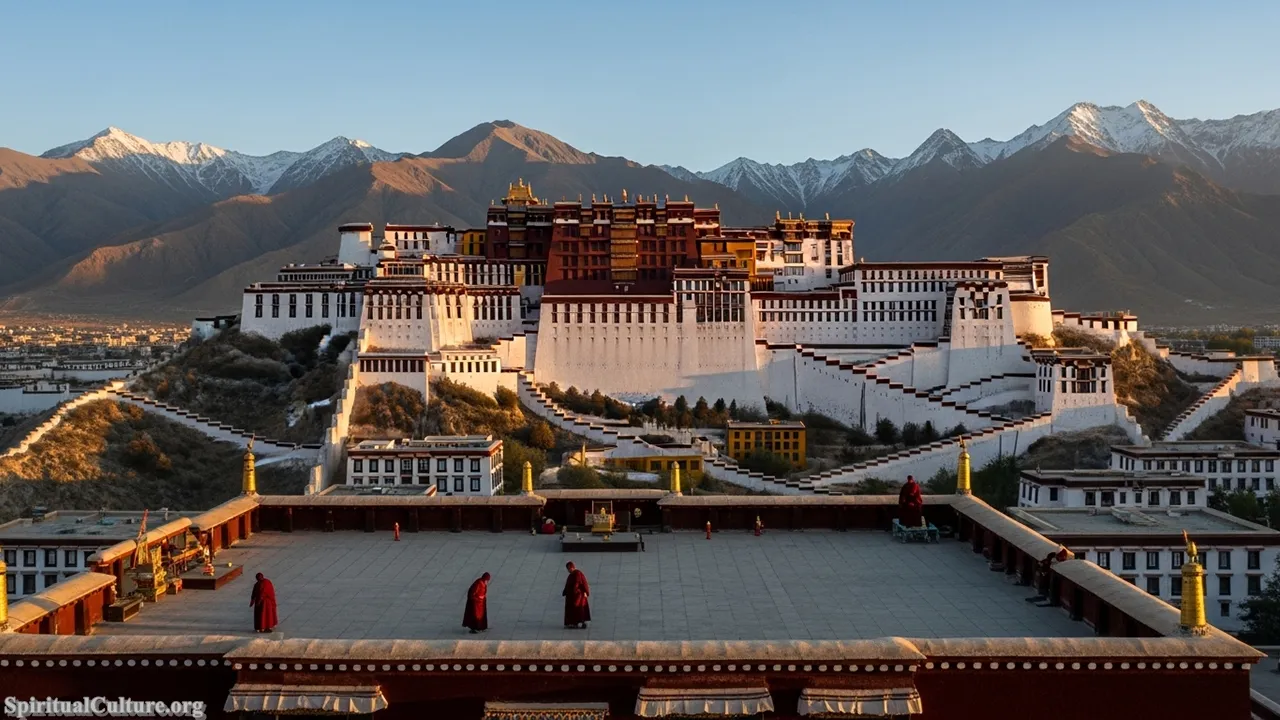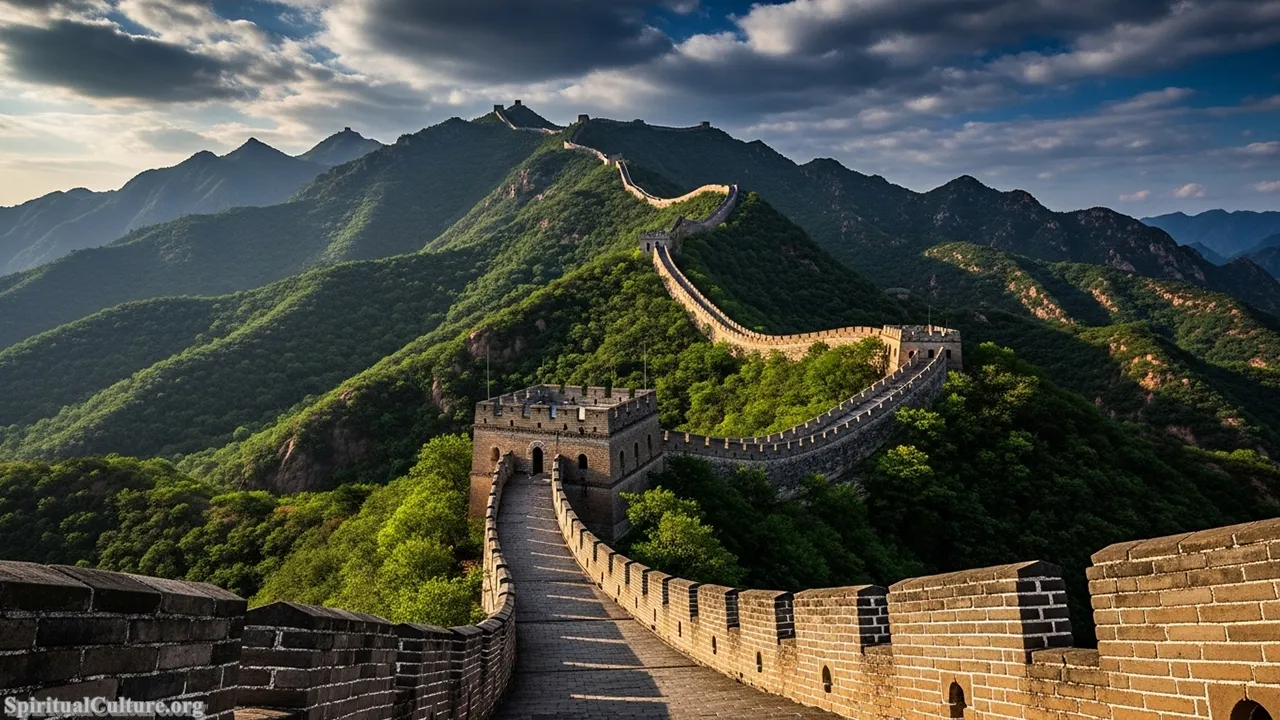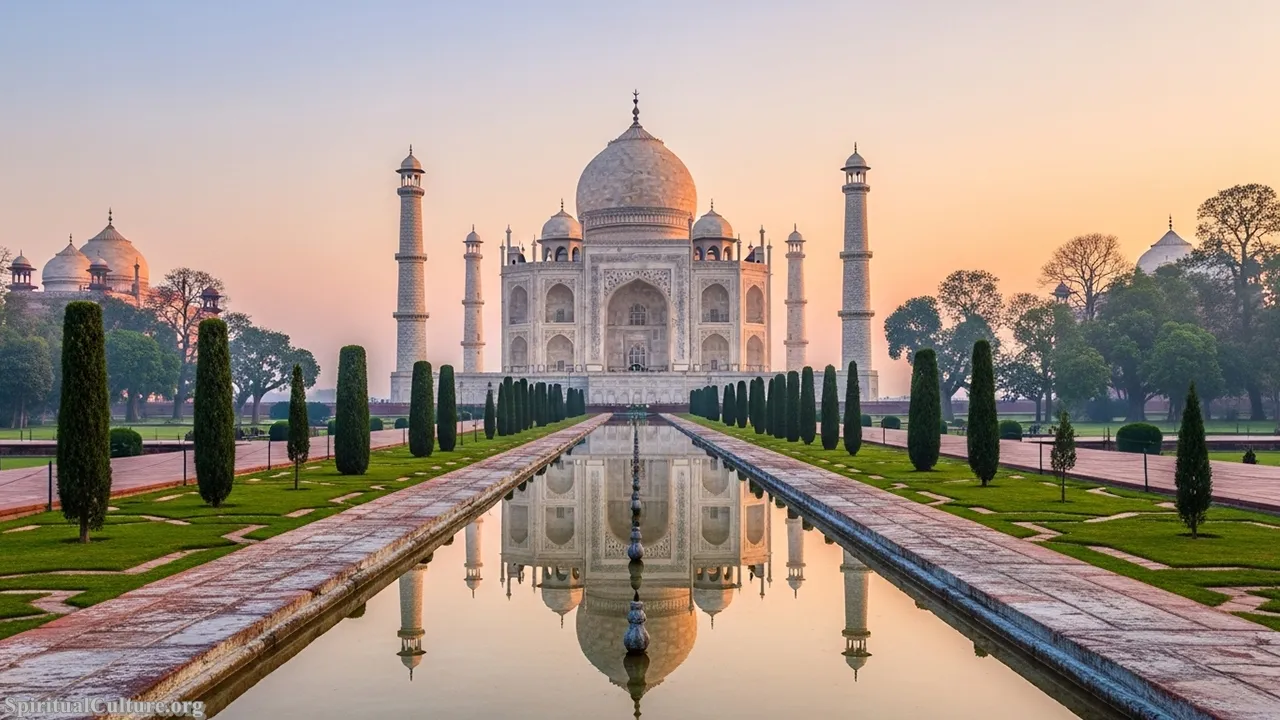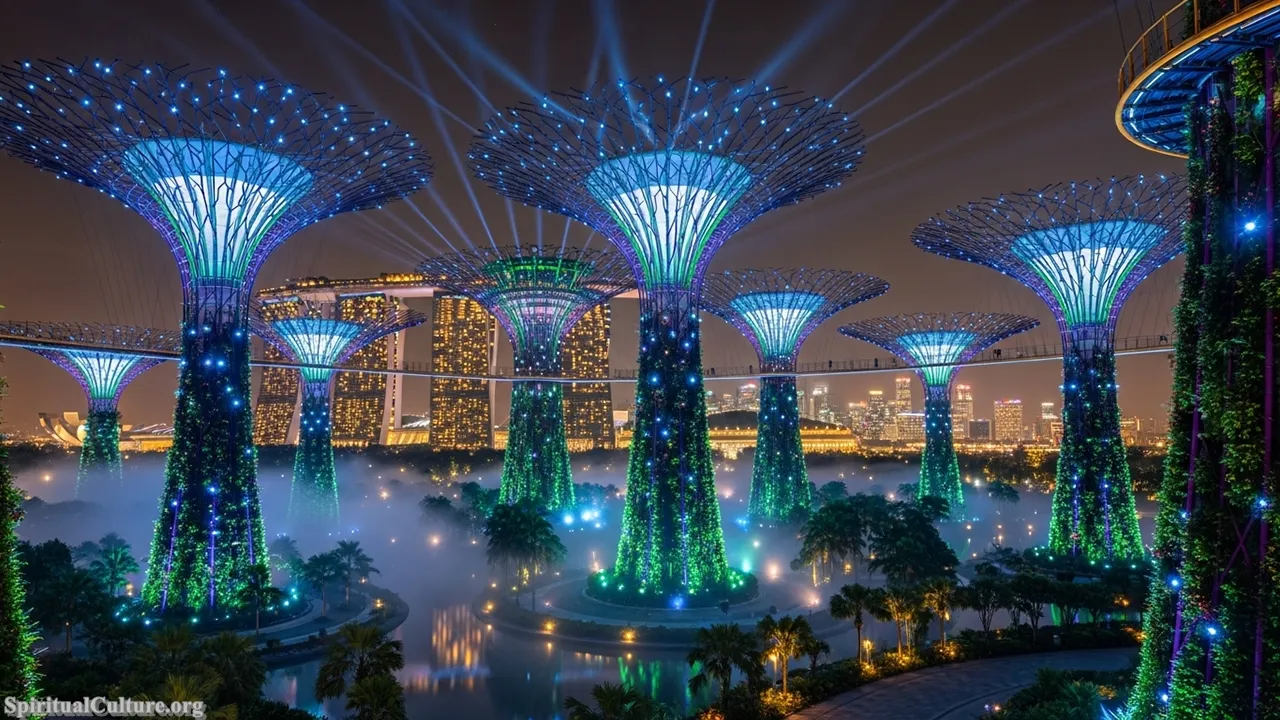The Spiritual Culture project is dedicated to exploring landmarks that transcend mere history and possess a profound, lasting impact on the human spirit. The designation of a site as a UNESCO World Heritage property grants it global recognition as being of “Outstanding Universal Value”—a shared legacy of humankind. As of the Current Time of Writing, there are over 1,200 such sites, but only a few possess the dual global fame and deep cultural/spiritual resonance that truly elevates them.
Our ranking is not simply based on visitor numbers but on a comprehensive assessment of the site’s influence: its unique testimony to a civilization, its spiritual significance (as a place of pilgrimage, ritual, or devotion), and its monumental role in shaping global cultural understanding. These locations serve as powerful touchstones, connecting us directly to the achievements, beliefs, and struggles of our collective past.
By delving into the deeper meaning behind these famous monuments, we hope to inspire a more reflective form of engagement, moving beyond mere sight-seeing to true spiritual appreciation. Each site on this list represents a pinnacle of human creativity and spiritual expression, enduring proof of the heights our ancestors could reach.
Table of the Top 10 World Heritage Sites with the Greatest Cultural and Spiritual Influence
| Rank | World Heritage Site | Country | Inscribed Year | Primary Cultural/Spiritual Value |
|---|---|---|---|---|
| 10 | Potala Palace | China (Tibet Autonomous Region) | 1994 | Seat of the Dalai Lama; Tibetan Buddhist Pilgrimage |
| 9 | Acropolis of Athens | Greece | 1987 | Birthplace of Western Democracy and Philosophy; Dedicated to Athena |
| 8 | Historic Centre of Rome | Italy | 1980, 1990 | Center of the Roman Empire and the Catholic Church (Vatican included) |
| 7 | Chichen Itzá | Mexico | 1988 | Major Mayan Political and Religious Center; Astronomical Precision |
| 6 | Borobudur Temple Compounds | Indonesia | 1991 | World’s Largest Buddhist Temple; Symbol of Enlightenment’s path |
| 5 | Petra | Jordan | 1985 | The “Rose City”; Nabataean Ingenuity and Crossroads of Ancient Trade/Culture |
| 4 | The Great Wall of China | China | 1987 | World’s Longest Building Project; Symbol of National Unity and Protection |
| 3 | Angkor Wat | Cambodia | 1992 | World’s Largest Religious Monument; Shift from Hindu to Buddhist Worship |
| 2 | Taj Mahal | India | 1983 | Masterpiece of Mughal Architecture; Universal Symbol of Eternal Love |
| 1 | Memphis and its Necropolis – The Pyramid Fields from Giza to Dahshur | Egypt | 1979 | Only remaining Ancient Wonder; Testimony to Old Kingdom Spiritual Beliefs and Immortality |
#10. Potala Palace (China)
The Potala Palace, dramatically perched atop Marpo Ri (‘Red Hill’) in Lhasa, stands as the towering spiritual and political heart of Tibetan Buddhism. Designated as a World Heritage Site in 1994, this complex served as the winter residence of the Dalai Lamas from the 7th century until 1959. Its imposing white and red structure, comprising the White Palace for administrative use and the Red Palace for religious functions, is an architectural marvel built into the challenging Himalayan landscape. As of the Current Time of Writing, it remains the ultimate destination for Buddhist pilgrims globally, symbolizing the profound endurance of Tibetan culture.

The reason for its placement in our top ten is the extraordinary spiritual impact it has exerted over centuries, acting as the epicenter of a unique and resilient spiritual tradition. The Red Palace, in particular, houses the golden stupas—the tombs of past Dalai Lamas—and numerous chapels, making it a powerful focus of devotion and meditation. It is not just a building; it is the embodied history of the compassionate Bodhisattva Avalokiteśvara, whom the Dalai Lamas are believed to embody, offering a spiritual refuge and a profound lesson in peace and political wisdom.
The preservation of the Potala Palace highlights the critical role of heritage conservation in protecting living religious traditions against the forces of time and political change. It serves as a moral lesson that true spiritual authority can be found in simplicity and compassion, even when housed in monumental grandeur. Its survival ensures that the world can continue to draw inspiration from the spiritual culture of Tibet, a source of wisdom often needed in the modern age.
Cultural/Spiritual Highlights:
- The former highest palace in the world, embodying a rare blend of governance and spiritual authority.
- Contains the remains and relics of eight Dalai Lamas, making it a paramount pilgrimage site.
- Features over 1,000 rooms and countless chapels dedicated to Buddhist deities and teachings.
#9. Acropolis of Athens (Greece)
The Acropolis of Athens, meaning ‘High City,’ is an ancient citadel that has stood watch over the Greek capital since the 5th century BC, symbolizing the height of classical Greek civilization. Inscribed in 1987, it hosts the Parthenon, the Erechtheion, and the Propylaea—monuments that represent the foundational principles of democracy, philosophy, and rational inquiry. This complex is a physical testament to the Golden Age of Athens, a cultural epoch that, as of the Current Time of Writing, continues to influence political systems, art, and intellectual thought across the globe.

Its high ranking is rooted in its irreplaceable role as a spiritual birthplace of Western intellectual culture. The Acropolis was primarily a religious sanctuary dedicated to the goddess Athena, whose Parthenon temple is considered the ultimate expression of architectural perfection and balance. The spiritual impact here is intellectual and philosophical, rather than purely devotional; it is the shrine of the mind, where the human capacity for reason and beauty was first celebrated on a monumental scale. The site’s harmony between logic and aesthetics is a deeply spiritual ideal.
The ongoing preservation efforts for the Acropolis demonstrate humanity’s commitment to protecting the sources of its own ideals. This site offers a powerful reflection on the value of inquiry and the pursuit of knowledge as a moral lesson for contemporary society. The resilience of the marble monuments encourages us to look for eternal, unchanging truths within a constantly shifting world.
Cultural/Spiritual Highlights:
- The Parthenon is a global symbol of classical art, democracy, and the rational mind.
- Dedicated to the goddess Athena, patron of wisdom, warfare, and craftsmanship.
- Represents the pinnacle of the Doric Order in classical Greek architecture.
#8. Historic Centre of Rome, Properties of the Holy See (Italy)
The Historic Centre of Rome, together with the Properties of the Holy See in the city (including the Vatican and the Basilica of St. Paul Outside the Walls), forms a singular, continuously-inhabited monumental area inscribed in 1980 and 1990. Encompassing monuments from the Roman Forum and the Colosseum to the Baroque grandeur of St. Peter’s Basilica, Rome represents a living, layered history of three millennia. This site is unique in its double role: the political and military core of a great ancient empire, and the spiritual nucleus of one of the world’s largest religions, Catholicism, a status firmly maintained as of the Current Time of Writing.

The sheer spiritual weight of Rome earns its spot, as it serves as the ultimate pilgrimage site for hundreds of millions of Christians worldwide. The area’s historical significance is immense, charting the trajectory from pagan empire to the emergence of a global faith. It bears exceptional testimony to a disappeared civilization (Roman Empire) and a living one (the Holy See), illustrating an unparalleled interchange of monumental arts and urban planning. The dual legacy is a constant spiritual reminder of how power shifts from the sword to the spirit.
Rome’s preservation challenges—balancing modern life with ancient ruins and active religious sites—offer a profound lesson on the continuity of cultural identity. The city’s ability to constantly reinvent itself while respecting its deeply-rooted spiritual foundations teaches us that heritage is a dynamic, living conversation, not a static relic. It celebrates the persistence of faith and the enduring human need for a central, sacred place.
Cultural/Spiritual Highlights:
- Includes the Vatican City State, the sovereign center of the Catholic Church.
- Features the Colosseum, a globally recognized symbol of the Roman Empire and a site of early Christian martyrdom.
- Represents over 3,000 years of continuous cultural and religious history.
#7. Chichen Itzá (Mexico)
Chichen Itzá, located on the Yucatán Peninsula, is one of the largest and most impressive Mayan cities, flourishing between the 9th and 13th centuries AD. Inscribed in 1988, the site is dominated by the monumental stepped pyramid, El Castillo (the Temple of Kukulcan), which serves as a massive solar calendar. This site provides exceptional testimony to the Mayan-Toltec civilization, demonstrating an advanced spiritual cosmology fused with unparalleled astronomical and mathematical precision. As of the Current Time of Writing, it stands as the most recognized symbol of the late Mayan cultural apogee.

Its high rank is justified by the profound spiritual and intellectual dimension embedded in its architecture. The 365 steps of El Castillo (one for each day of the year) perfectly align with the equinoxes, where the shadow of the feathered serpent god Kukulcan descends the staircase—a powerful intersection of religion and science. This ritualistic architecture reflects a deep spiritual culture that saw the cosmos, time, and the agricultural cycle as inseparable. The spiritual impact lies in its stunning demonstration of human knowledge and its integration into religious life, showing a harmonious relationship with the celestial order.
The moral lesson drawn from Chichen Itzá’s legacy is the power of intellectual pursuit in service of spiritual understanding. The site’s preservation is a call to value indigenous knowledge systems and the sophisticated spiritual practices they fostered. It reflects the universal human quest to understand one’s place in the vastness of the universe, a quest that culminated in these monumental, cosmically aligned structures.
Cultural/Spiritual Highlights:
- The El Castillo pyramid perfectly functions as a calendar, with 365 steps.
- Features the iconic astronomical phenomenon of the Serpent’s shadow during the equinoxes.
- A major center for the cult of the feathered serpent god, Kukulcan (Quetzalcoatl).
#6. Borobudur Temple Compounds (Indonesia)
Located in Central Java, the Borobudur Temple Compounds, inscribed in 1991, house the world’s largest and most magnificent Buddhist monument. Built in the 9th century, this immense stone structure is a three-dimensional representation of the path to spiritual enlightenment, comprising nine stacked platforms (six square and three circular) crowned by a central stupa. The monument is adorned with 2,672 relief panels and 504 Buddha statues, meticulously detailing the life of the Buddha and the concepts of karma, rebirth, and the ultimate path of a Bodhisattva. As of the Current Time of Writing, it is a primary pilgrimage destination for Indonesian Buddhists and a global architectural icon.

We place Borobudur high due to its unique embodiment of the entire Mahayana Buddhist cosmology in physical, walkable form. The process of circumambulating the temple’s terraces is a physical and spiritual journey, beginning in the earthly realm and ascending toward the final, formless, and empty state of Nirvana. The spiritual impact is immense, acting as a colossal meditation tool that visually narrates the moral and philosophical teachings of Buddhism. It stands as a powerful testament to the influence of Indian culture adapted into a distinctly Javanese style.
The restoration of Borobudur, a major UNESCO success story, provides a moral lesson in cultural resilience and international cooperation for heritage protection. Its very structure encourages a reflective, step-by-step approach to life’s challenges, reminding visitors that spiritual progress is a steady climb, with the reward of clear vision at the summit. It celebrates the universal appeal of the Buddhist quest for inner peace.
Cultural/Spiritual Highlights:
- A Mandala in stone, representing the entire cosmos and the Buddhist spiritual path.
- Contains 2,672 narrative relief panels, illustrating the Jataka tales and life of the Buddha.
- The largest monument to Mahayana Buddhism globally, still an active site of pilgrimage.
#5. Petra (Jordan)
Petra, the legendary “Rose City,” is an archaeological masterpiece carved directly into the red sandstone cliffs of Jordan. Inscribed in 1985, it was the capital of the Nabataean kingdom from the 4th century BC to the 1st century AD. Its fame rests on the extraordinary façade of Al-Khazneh (The Treasury) and Al-Deir (The Monastery), both massive rock-cut structures that testify to an ingenious and lost civilization. As of the Current Time of Writing, its fame has been cemented globally, attracting visitors captivated by its dramatic setting and the mystery of its sudden decline.

Petra’s elevated position in this ranking is due to its potent spiritual resonance as a monumental city of the dead and a historical crossroads. The rock-cut tombs and high places of sacrifice suggest a powerful spiritual culture centered on ancestor worship and communion with the gods of the mountain and water. The journey through the Siq, a narrow canyon, acts as a spiritual rite of passage, preparing the visitor for the revelation of the Al-Khazneh—a structure believed by many to be a mausoleum or a temple. The spiritual impact is one of awe, mystery, and the contemplation of transience, illustrating the deep connection between architecture and the afterlife.
The preservation of Petra, particularly its delicate sandstone facades, offers a reflection on the vulnerability of our past treasures to natural and human forces. The moral lesson is the ingenuity and adaptability of the human spirit, which carved a magnificent civilization out of a harsh desert landscape. Petra celebrates the power of belief and commerce to converge and create monumental beauty.
Cultural/Spiritual Highlights:
- The Nabataean city was a major crossroads for ancient trade routes, facilitating cultural exchange.
- Features monumental, rock-cut tombs and High Places of Sacrifice, indicating profound religious practices.
- Its unique water-harnessing system symbolizes the ability to find sacred life in the desert.
#4. The Great Wall of China (China)
Stretching over 20,000 kilometers across the rugged landscape of northern China, The Great Wall is the longest building project ever undertaken by human hands, inscribed in 1987. Though often incorrectly viewed as a single, continuous structure, it is a vast system of fortifications, watchtowers, and natural barriers built over centuries, primarily from the 3rd century BC to the Ming Dynasty (1368–1644). This monumental work stands as the definitive symbol of China’s national identity, its history of self-protection, and the immense organizational capacity of its imperial governments, a testament that is still profoundly visible as of the Current Time of Writing.

The Wall’s true spiritual power is found in its representation of collective human will and the spiritual meaning of a national boundary. It is a monumental sacrifice, symbolizing the vast effort and countless lives expended in the name of security and continuity. The spiritual impact is less about organized religion and more about the cultural value of unification and endurance. Walking upon its battlements evokes a profound sense of scale and commitment, embodying the Confucian ideal of social order and protective duty. It marks the spiritual separation between the agrarian civilization of the Han Chinese and the nomadic cultures of the north.
The Wall’s preservation, despite millennia of erosion and neglect, serves as a moral lesson in the long-term cost and value of separation versus connection. It encourages a reflection on the spiritual necessity of boundaries while simultaneously highlighting the shared humanity of all people on both sides of the divide. The Wall is a celebrative icon of survival and collective memory.
Cultural/Spiritual Highlights:
- The world’s largest man-made structure, symbolizing the collective will of a nation.
- Represents the historical and spiritual boundary between agrarian and nomadic cultures.
- A powerful symbol of national unity, resilience, and imperial authority across dynasties.
#3. Angkor Wat (Cambodia)
Angkor Wat, inscribed in 1992, is the largest religious monument in the world and the primary temple in the vast Angkor Archaeological Park. Originally constructed in the 12th century as a Hindu temple dedicated to the god Vishnu for the Khmer King Suryavarman II, it was gradually transformed into a Buddhist temple toward the end of the century. Its five iconic lotus-bud towers and mile-long bas-reliefs detailing Hindu epics and Khmer history make it an architectural and spiritual pinnacle of the Khmer Empire. As of the Current Time of Writing, the silhouette of Angkor Wat remains the defining emblem of the Cambodian nation and its Buddhist faith.

This site secures the third spot due to its astounding scale and its profound illustration of spiritual transition. The temple’s perfect symmetry represents the cosmic Mount Meru, the home of the Hindu gods, demonstrating an elaborate cosmological spiritual vision made manifest in stone. Its unique shift in devotion, embracing both Vishnu and the Buddha over time, reflects an exceptional capacity for cultural interchange and spiritual synthesis. The sheer effort and artistry involved—spanning generations—showcases the deepest possible spiritual devotion of a great civilization toward its deities and its kings.
Angkor Wat’s endurance, despite being swallowed by the jungle and surviving centuries of conflict, provides a powerful moral lesson on the spiritual cycle of decay and rebirth. Its careful restoration and continuing use as a place of Buddhist worship and pilgrimage underscores the preservation value of heritage sites that remain culturally vital. It celebrates the deep, mystical connection between the king, the cosmos, and the spiritual well-being of the Khmer people.
Cultural/Spiritual Highlights:
- The largest religious monument in the world, originally dedicated to the Hindu god Vishnu.
- Architecturally designed to represent Mount Meru, the mythical home of the gods.
- Features extensive bas-reliefs detailing the Hindu epics and historical battles.
#2. Taj Mahal (India)
The Taj Mahal, inscribed in 1983, is a gleaming white marble mausoleum located on the south bank of the Yamuna River in Agra, India. It was commissioned in 1632 by the Mughal Emperor Shah Jahan to house the tomb of his favorite wife, Mumtaz Mahal. Considered the jewel of Muslim art in India and one of the universally admired masterpieces of the world’s heritage, it perfectly synthesizes Persian, Islamic, and Indian architectural styles. As of the Current Time of Writing, the Taj Mahal stands as the single most powerful universal symbol of perfect, immortal love and devotion, resonating far beyond its religious or architectural context.

Its high ranking is earned not just by its architectural perfection, but by the deeply human and spiritual meaning of its creation. The Taj Mahal is a vision of Paradise on Earth, intended as a garden where the beloved could rest in eternal peace, reflecting the spiritual belief in the afterlife as a beautiful garden setting. The use of intricate calligraphy, geometric patterns, and inlay work (pietra dura) transforms the structure into an act of devotion, where beauty itself becomes a form of worship. The spiritual impact is the universal emotion it evokes: the transcending power of love over death, a fundamental human truth.
The preservation of the Taj Mahal is a continuous, globally monitored effort, highlighting the responsibility we have to protect monuments tied to core human values. Its existence offers the moral lesson that the greatest human works are often motivated by the deepest emotional and spiritual bonds. The Taj Mahal celebrates a timeless quality, where architectural genius is placed at the service of an eternal spiritual sentiment.
Cultural/Spiritual Highlights:
- A global symbol of eternal love and devotion, commissioned by Emperor Shah Jahan.
- Considered the zenith of Mughal architecture, blending Persian, Islamic, and Indian styles.
- Designed to represent a vision of Paradise (Jannat), reflecting Islamic concepts of the afterlife.
#1. Memphis and its Necropolis – The Pyramid Fields from Giza to Dahshur (Egypt)
The Pyramid Fields from Giza to Dahshur, inscribed in 1979, contain the colossal masterpieces of the ancient world, most notably the Great Pyramid of Khufu (Cheops), the only surviving member of the Seven Wonders of the Ancient World. These monuments served as the royal necropolises of the Old Kingdom pharaohs and testify to the power, religious beliefs, and astronomical knowledge of the ancient Egyptian civilization over four millennia ago. As of the Current Time of Writing, the Pyramids remain the most globally recognized, influential, and enduring cultural icon of antiquity.

We rank the Giza Pyramids as the pinnacle because their spiritual impact is synonymous with the human quest for immortality and the divine. These were not mere tombs, but cosmic engines—metaphysical ramps intended to propel the deceased pharaoh’s soul toward the sun god Re and ensure the spiritual continuation of Egyptian order (Ma’at). The staggering technical achievement required to align them perfectly with the cardinal directions and celestial bodies is a physical manifestation of a profound, sophisticated spiritual cosmology. Their sheer age and scale—standing since the dawn of recorded history—give them an unmatched spiritual authority.
The preservation of the Pyramids, largely due to their impeccable construction and the stable desert climate, serves as a powerful moral lesson in building for the ages and valuing the spiritual legacy left behind. They stand as a silent, monolithic reflection of humanity’s deepest hope: to conquer death through monumental effort and spiritual dedication. The Pyramids of Giza celebrate the oldest and most compelling spiritual desire of all: life everlasting.
Cultural/Spiritual Highlights:
- The Great Pyramid of Giza is the last remaining of the original Seven Wonders of the Ancient World.
- Symbolizes the ancient Egyptian belief in the Pharaoh’s journey to the sun god Re and the spiritual pursuit of immortality.
- Represents the zenith of Old Kingdom engineering and astronomical-religious alignment.
Conclusion
The ten sites we have explored represent the very best of humanity’s cultural and spiritual heritage, each one a profound narrative etched into the Earth. From the perfect geometry of the Taj Mahal’s eternal devotion to the monolithic spiritual ambition of the Giza Pyramids, these monuments offer more than historical data; they offer a sense of awe and a direct connection to the fundamental human desire for meaning, beauty, and transcendence. They confirm the Spiritual Culture principle: that the greatest human works are born from a deeply held spiritual conviction.
As we navigate the modern world, the preservation of these universal landmarks, as championed by UNESCO, becomes a collective act of remembrance and an investment in our shared moral and cultural future. They are our global heritage, reminding us that, despite our differences, we are all inheritors of a magnificent and profound spiritual civilization.




